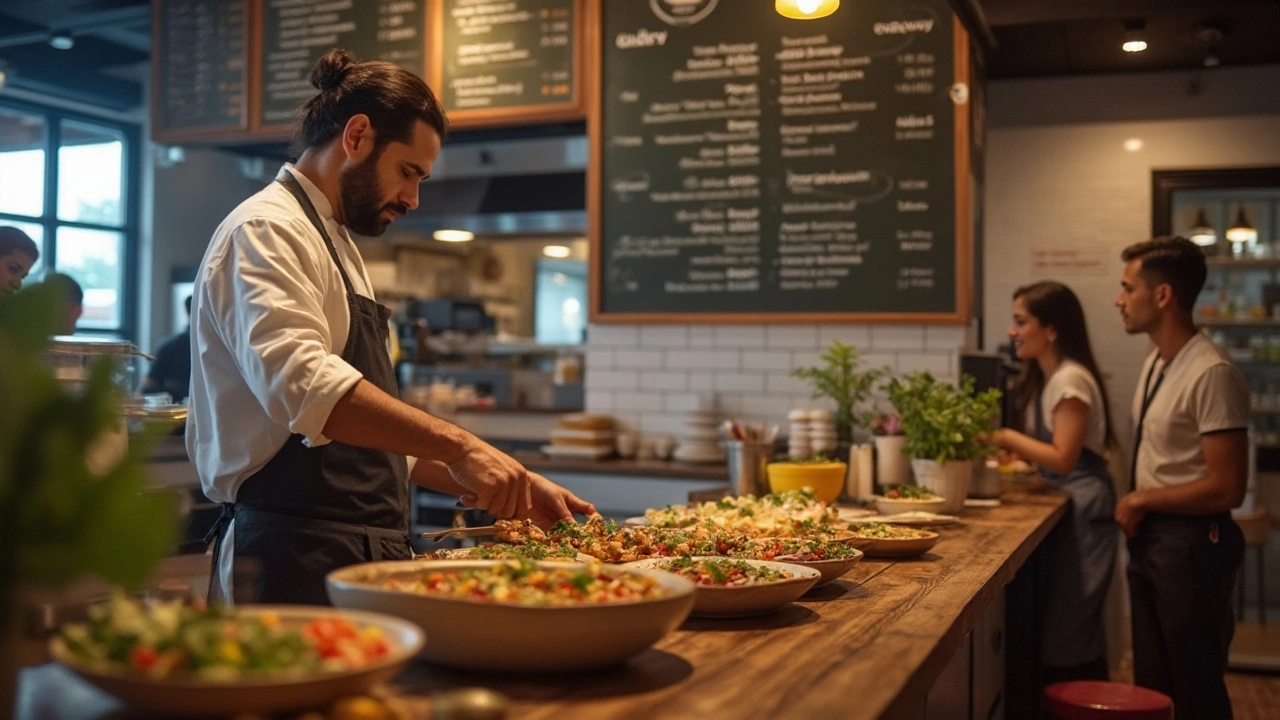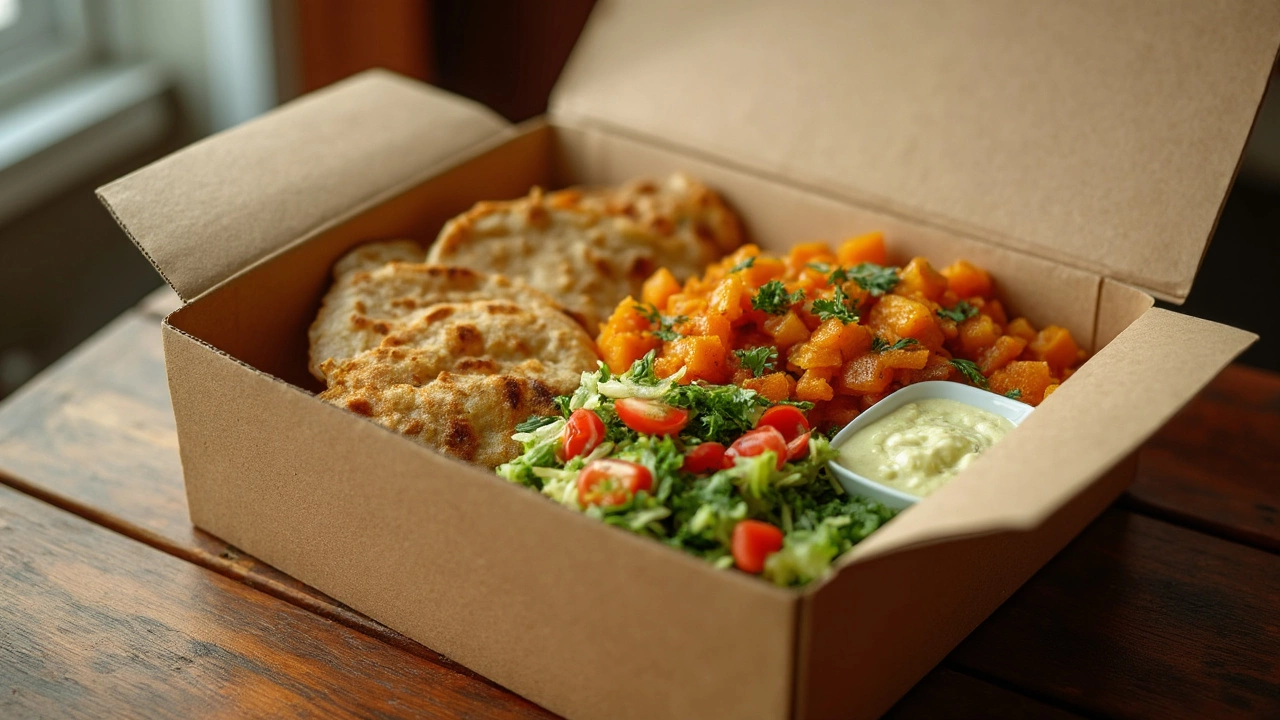Think Indian takeaway and most people picture buttery naan, creamy curries, and crispy fried snacks. But hang on—does every order have to be a diet disaster? Absolutely not. There are legit healthy choices that don’t taste bland or boring.
You can totally enjoy your samosas and still keep things light, if you just know what to look for. Some classic snacks like roasted chana or steamed idlis are packed with protein and fiber, and way lighter on oils than the usual suspects. It’s all about swapping the deep-fried for the grilled or steamed—and keeping a close eye on the sauces and extras.
If you want to avoid that heavy, stuffed feeling after your meal (or the guilt that sometimes follows), a few tweaks to your order can make all the difference. Let’s demystify the menu and pick out the best bits so you don’t have to guess.
- Why Typical Takeaway Choices Aren't Always Healthy
- Top Healthy Indian Snacks You Can Actually Order
- Decoding the Menu: Spotting Hidden Calories
- Simple Tips to Upgrade Your Takeaway Order
- FAQ: Your Healthy Takeaway Questions Answered
Why Typical Takeaway Choices Aren't Always Healthy
When you peek at the menu from your favorite Indian takeaway, a lot of what jumps out isn’t doing your body any favors. Here’s the thing: many popular dishes are deep-fried, overloaded with cream or ghee, and stacked with hidden sugars or salt. Sure, they taste amazing, but the calorie and fat numbers add up pretty fast. Ever wondered why you feel so heavy or thirsty after a feast? That’s often from all the added oil and sodium.
Check out a quick nutrition breakdown for some of the usual suspects:
| Dish | Average Calories (per serving) | Main Issues |
|---|---|---|
| Paneer Butter Masala | 450-600 | High in cream, butter, oil |
| Chicken Korma | 500-700 | Heavy cream, nuts, sugar |
| Samosa (2 pieces) | 300-350 | Deep-fried, carb-heavy |
| Gulab Jamun (2 pieces) | 300-400 | Fried, sugar syrup |
| Garlic Naan | 250-300 | Refined flour, butter |
Notice a pattern? The stuff we order the most is usually dripping with oil or loaded with heavy dairy. Even some veggie items get dunked in batter and hit the fryer. It’s not just about calories—even breads like naan or bhatura are often made with refined flour, which offers zero nutrition and just spikes your blood sugar.
- Added cream or ghee can make a single curry more than double in fat and calories.
- A full takeaway meal can easily hit 1,500-2,000 calories without you realizing.
- Sauces and chutneys often hide extra sugar and salt, too.
This doesn’t mean you should swear off takeout forever. Just knowing what’s in your food puts you in control. The trick? Spot the heavy hitters and swap them for lighter, fresh options. If you’re looking for healthy Indian snacks, you’ll want to look past the fried, creamy classics and get creative.
Top Healthy Indian Snacks You Can Actually Order
If you’re staring at the Indian takeaway menu, wondering what won’t mess with your healthy eating goals, you’ve got more options than just salad. Here’s a breakdown of snacks you can usually find (or ask for) that don’t drown your diet in oil and cream.
- Dhokla: This steamed chickpea flour cake is low in calories, full of protein, and super light. Plus, it’s easy on the stomach and usually topped with mustard seeds and coriander—not greasy stuff.
- Tandoori Chicken: Grilled in a clay oven, not fried. Lean protein, tons of flavor, and basically no extra oil. Just ask for less butter on top and skip the creamy sauces.
- Chana Chaat: Made from boiled chickpeas, onions, tomatoes, and tangy spices. It’s high in fiber, keeps you full, and isn’t cooked in oil. Bonus: you can ask for less potato if you want to cut carbs even more.
- Idli with Sambar: Steamed rice and lentil cakes served with lentil soup. Idlis are light, have no added fat, and you get a good amount of plant protein.
- Moong Dal Chilla: These are basically savory pancakes made from moong dal (split yellow lentils). Grilled, not fried, and good for anyone watching their calories.
Wondering how these snacks stack up nutritionally compared to common fried snacks? Here’s a quick cheat sheet:
| Snack | Calories (per serving) | Protein (g) | Fat (g) | Fiber (g) |
|---|---|---|---|---|
| Dhokla | 152 | 6 | 2 | 3 |
| Tandoori Chicken (1 piece) | 120 | 13 | 4 | 0 |
| Chana Chaat (1 cup) | 180 | 7 | 3 | 8 |
| Idli (2 pieces) | 70 | 2 | 0.5 | 1 |
| Moong Dal Chilla (1 piece) | 100 | 6 | 2 | 2 |
| Samosa (fried, 1 piece) | 262 | 4 | 17 | 2 |
See how something like a healthy Indian snack (looking at you, dhokla and chilla) easily beats out a fried samosa? The trick is sticking with grilled, steamed, or boiled items and holding off on heavy chutneys or cream-based sauces. If you’re still not sure, ask the restaurant if they can prepare things with less oil—most places are happy to help.

Decoding the Menu: Spotting Hidden Calories
Menus can be sneaky. Something might look healthy but pack in more calories than you expect. A basic dal, for example, sounds safe but can end up heavy if it’s loaded with ghee on top. Pakoras? Sure, they’re made from vegetables, but deep-frying means they end up with way more fat than you’d think!
Here’s a quick look at some popular Indian snacks. Calories can jump up fast, especially with fried, buttery, or creamy options:
| Snack | Avg. Calories per Serving | Hidden Culprit |
|---|---|---|
| Samosa (1 piece) | 140-180 | Deep fried; stuffed with potato |
| Papdi Chaat | 350-400 | Fried papdi; sweetened chutney |
| Medu Vada (1 piece) | 70-100 | Deep fried |
| Paneer Tikka (grilled) | 180-200 | Marinade may include cream |
| Steamed Idli (2 pieces) | 80-90 | Rice content; usually safe |
| Roasted Chana | 110 (handful) | Low risk; fiber-rich |
Most calories sneak in from three main things:
- Oils and Ghee: Fried foods and tempering add tons of extra calories. Even a healthy lentil soup can double up if drowned in butter.
- Cream, Butter, or Coconut Milk: Sauces or marinades can look innocent, but all those creamy or buttery gravies can shock you with their calorie hit.
- Sugar in Chutneys/Sauces: Extra sugar hides in sweet tamarind chutney or even in yogurt-based dips.
Watch out for words like “malai,” “butter,” or “makhani.” Even dishes that seem grilled or steamed might have a dollop of cream or a swipe of butter right at the end—you can always ask for these to be skipped. Pro tip: order sides and sauces on the side, so you can control how much goes in. And if you see “deep-fried” or “crispy,” ask about baked or roasted options if the restaurant offers them.
Picking from the healthy Indian snacks on the menu is honestly just about reading between the lines and not getting tricked by innocently worded descriptions. Stay aware, and you’ll end up enjoying your takeaway while keeping calories in check.
Simple Tips to Upgrade Your Takeaway Order
Making your Indian takeaway order healthier is much easier than people think. Tiny changes add up, and you don’t need to give up flavor to eat smart. Here’s how you can enjoy your favorite healthy Indian snacks without feeling like you’re on a diet.
- Go for grilled or steamed: Items like tandoori chicken, paneer tikka, and steamed idlis have way less oil than their fried cousins. Skip the bhajiyas or pakoras if you’re watching calories.
- Pick whole grains: Swap white naan or rice for whole wheat roti or brown rice if available. These alternatives have more fiber and keep you full for longer.
- Watch the sauces: Creamy sauces (like butter chicken’s famous gravy) are loaded with extra fat. Go light on the gravies, or ask for them on the side so you control the amount.
- Load up on legumes: Chana masala, rajma (kidney beans), and dal are packed with protein and fiber, making them nourishing but not heavy.
- Extra veggies, please: Ask for extra veggies in your curries, wraps, or sides. Indian food has loads of options like bhindi, gobi, or mixed veg—load up whenever you can.
- Downsize portions: Share mains or order half portions where possible. Indian takeaway is usually big enough to share, so this simple step can help you cut extra calories without even thinking about it.
- Request less oil or butter: Most places are happy to cook your food with less oil or butter if you just ask. Don’t be shy about this—they get these requests all the time, especially now.
Sometimes numbers make it real. Here’s a simple breakdown of average calories in common Indian takeaway options:
| Item | Typical Calories (per serving) |
|---|---|
| Vegetable Pakora (fried) | approx. 260 |
| Tandoori Chicken (grilled) | approx. 120 |
| Steamed Idli | approx. 70 |
| Dal Tadka | approx. 180 |
| Butter Chicken Gravy (1 serving) | approx. 350 |
| Whole Wheat Roti | approx. 80 |
One last thing—order fresh salads or raita on the side. They’re not just filler; they help balance out stronger flavors and add nutrients you’re probably missing elsewhere on the menu.

FAQ: Your Healthy Takeaway Questions Answered
Still got doubts about ordering the healthy Indian snacks from your favourite takeaway? You’re not alone. Here’s what people always ask—and straight, simple answers to help you out.
Q1: Is ordering tandoori dishes really healthier than other options?
Yep. Tandoori items like chicken, fish, or even paneer are cooked in a clay oven, not fried in oil. According to India’s National Institute of Nutrition, grilled foods generally hold onto more nutrients and have much less fat than their deep-fried cousins. You’re cutting out a heap of unnecessary oil and stopping the calorie count from shooting up.
Q2: Are dals good for a quick, healthy meal?
Absolutely. Dals (lentil-based dishes) are high in protein, fiber, and minerals. A cup of plain dal tadka (without heavy cream or extra ghee) clocks in at just around 180–220 calories and keeps you full for hours. Just be wary of extra makhan (butter) and cream that some takeaways add for extra flavor.
Q3: What are some healthy Indian bread choices?
Go for whole wheat roti or phulka instead of naan or parathas loaded with butter. Phulkas are made with minimal oil, usually none. If you really want naan, ask if they can make it without butter or ghee.
| Bread | Calories (approx per piece) |
|---|---|
| Whole wheat roti | 70 |
| Plain naan | 120 |
| Stuffed paratha (aloo) | 180 |
| Butter naan | 200 |
Q4: Is rice always a bad choice?
White rice isn’t the enemy, but portion size matters a ton. Try swapping to brown rice or have a small serving with a heavier focus on dal, sabzi, or grilled protein.
Q5: What’s one thing I should always avoid?
Papad and fried snacks like samosas or pakoras are tasty, but loaded with fat and salt. The Indian Heart Journal (2023 study) found that regularly eating deep-fried snacks can spike cholesterol levels.
"If you stick to grilled, steamed, or roasted options and fill half your plate with veggies and lean protein, you’ll avoid most of the unhealthy trap foods that make takeaway a guilty pleasure." — Dr. Meera Sharma, Clinical Nutritionist, AIIMS Delhi
Remember, you don’t have to give up takeaway to stick to your healthy eating goals. A little menu-reading and smart swaps go a long way.
